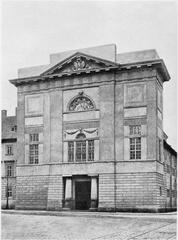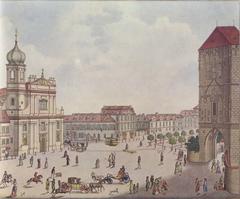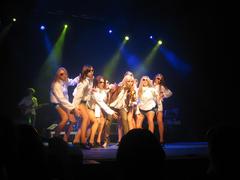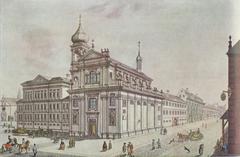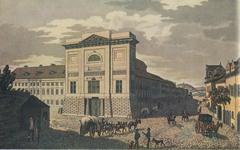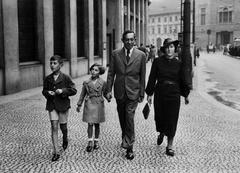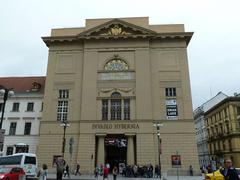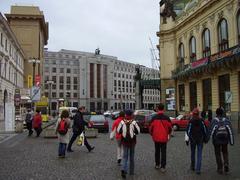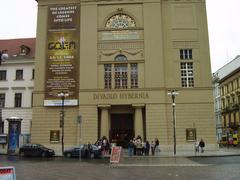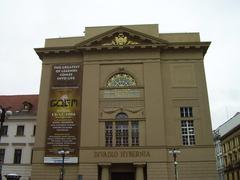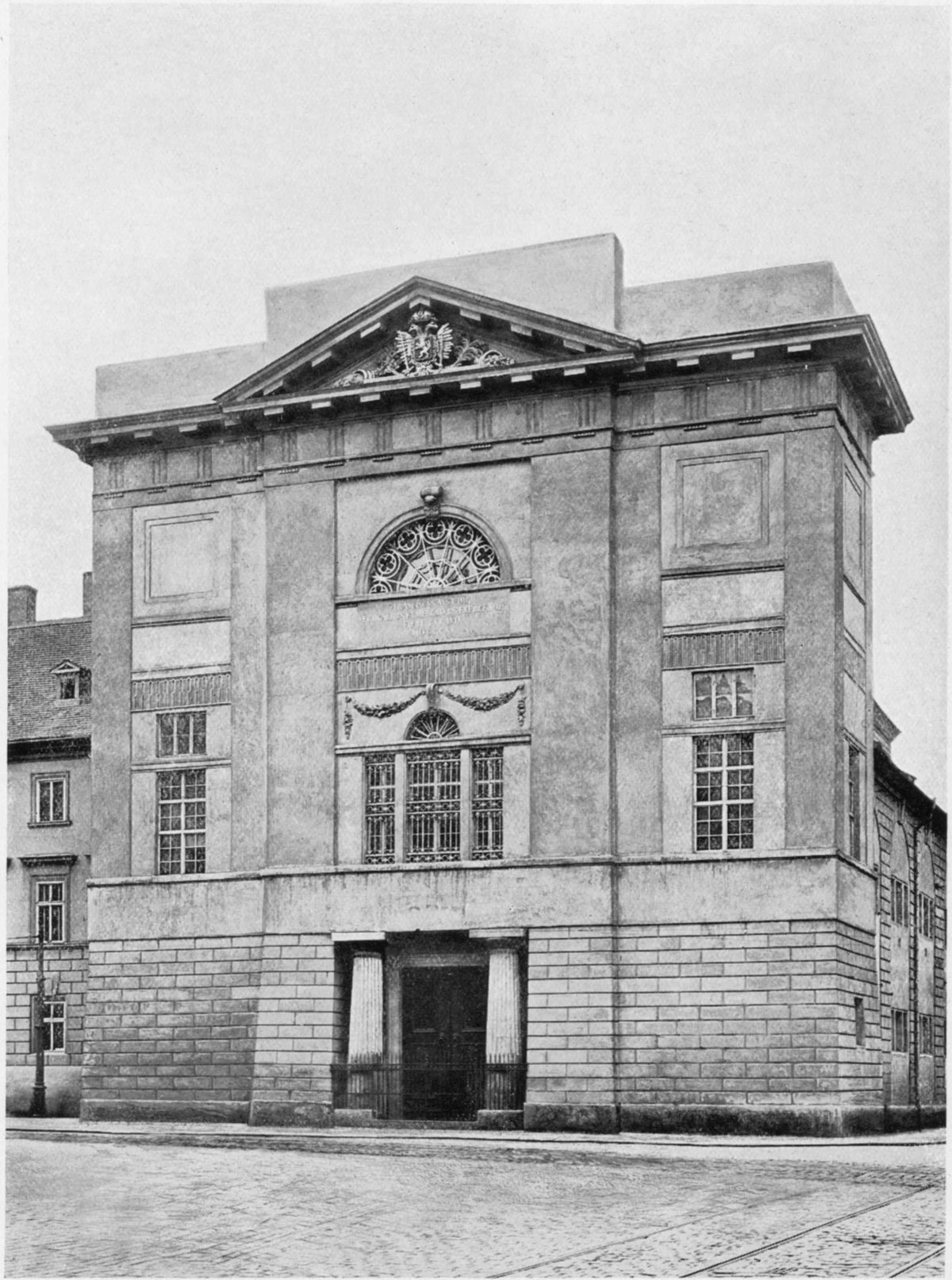
U Hybernů Prague: Visiting Hours, Tickets, and Historical Site Guide
Date: 14/06/2025
Introduction
U Hybernů, also known as Hybernia Theatre (Divadlo Hybernia), is a remarkable historical and cultural landmark situated in the heart of Prague at Náměstí Republiky. This iconic building has witnessed centuries of transformation—from its origins as an Irish Franciscan monastery in the 17th century to its current role as a vibrant theatre and cultural venue. U Hybernů offers a unique experience, blending architectural grandeur, rich history, and modern artistic performances, making it an essential stop for anyone exploring Prague’s storied past and thriving cultural present.
This comprehensive guide details everything you need to know for an enriching visit: historical context, architectural highlights, visiting hours, ticketing, accessibility, travel tips, and nearby attractions. Whether you are a history buff, architecture enthusiast, or culture lover, U Hybernů promises an unforgettable journey through Prague’s heritage.
For the latest event schedules, tickets, and visitor information, refer to the official Hybernia Theatre website, and explore further historical insights at theatre-architecture.eu. For broader context on Prague’s architecture and attractions, see guides such as prague-guide.co.uk and pragueviews.com.
Table of Contents
- Introduction
- Historical Background
- Architectural Significance
- Cultural Importance
- Visitor Information
- Special Experiences
- Nearby Attractions
- Frequently Asked Questions (FAQ)
- Conclusion and Call to Action
- Sources
Historical Background
Origins and Religious Heritage
U Hybernů’s story begins in the early 17th century when Irish Franciscan monks, known as Hybernians (from the Latin “Hybernia” for Ireland), established a monastery and church on this site after being exiled from Ireland. With support from Emperor Ferdinand II, construction of the Baroque church dedicated to the Immaculate Conception of the Virgin Mary commenced in 1653 under Italian architect Carlo Lurago. The church was notable for its rare, towerless Baroque façade and quickly became a vital religious and cultural center for Prague’s Irish Catholic community (theatre-architecture.eu; prague-guide.co.uk).
Secularization and Empire-Style Transformation
In 1785, Emperor Joseph II’s reforms led to the dissolution of many monastic institutions, including the Irish Franciscan monastery at U Hybernů. The complex was deconsecrated and repurposed for secular use. Between 1808 and 1811, architects Josef Zobel, Georg Fischer, and Jan Filip Joendl transformed the building into a customs house, replacing the Baroque façade with a monumental Empire-style design inspired by Berlin’s Mint. This neoclassical adaptation introduced massive Doric columns and symmetrical forms, establishing one of Prague’s best-preserved Empire-style façades (hybernia.eu; theatre-architecture.eu).
20th Century Adaptations and Modern Use
The building continued to evolve, serving as a customs office, military building, financial office, and exhibition hall throughout the 19th and 20th centuries. Architect Josef Karel Říha’s 1938 redesign converted it into an exhibition space, a function it held until closure in 1991 due to deterioration (theatre-architecture.eu).
After extensive renovation, U Hybernů reopened as Hybernia Theatre in 2006, hosting musicals, concerts, and multimedia exhibitions. Its inaugural show was the musical “Golem” by Karel Svoboda, marking a new era in the building’s vibrant cultural life (theatre-architecture.eu).
Architectural Significance
Baroque Foundations
Carlo Lurago’s original Baroque church featured a distinctive towerless façade, a rarity in Czech sacred architecture and a nod to Italian design. Its prominent location opposite the Powder Gate and near the Municipal House enhanced its ceremonial presence in the cityscape (theatre-architecture.eu).
Empire-Style Masterpiece
The early 19th-century transformation established U Hybernů as a major Empire-style monument. The façade’s massive Doric columns and monumental proportions stand in striking contrast to nearby Baroque and Art Nouveau landmarks, such as the Municipal House, enriching Prague’s architectural diversity (hybernia.eu).
Urban Setting
Strategically positioned at the intersection of Hybernská Street and Republic Square, U Hybernů anchors a key axis in Prague’s urban landscape. Its proximity to the Gothic Powder Gate, Municipal House, and Czech National Bank creates a vivid architectural dialogue and situates the building at the heart of the city’s historical and cultural district (pragueviews.com).
Cultural Importance
U Hybernů’s varied history mirrors Prague’s own evolution—from a religious sanctuary to an imperial customs house, exhibition hall, and contemporary theatre. It remains a symbol of adaptation and preservation, embodying the city’s capacity to repurpose and celebrate its architectural heritage. Today, the Hybernia Theatre is a leading venue for musicals, concerts, and multimedia events, contributing significantly to Prague’s thriving arts scene (mzv.gov.cz).
Visitor Information
Visiting Hours
- Box Office: Generally open from 10:00 AM to 6:00 PM, Monday through Saturday.
- Performances: Evening shows typically start around 19:00; matinees may be scheduled on weekends and holidays.
- Exhibitions: Daytime hours vary; check the official program for current schedules.
Arrive at least 20–30 minutes before your event for ticket collection and to explore the venue.
Tickets & Admission
- Purchase: Tickets can be bought online via the Hybernia Theatre website, at the box office, or through authorized partners.
- Pricing: Musicals and major shows range from 400–1,200 CZK; exhibitions typically 150–350 CZK.
- Discounts: Students, seniors, children, and groups may receive reduced rates.
- Language: Most performances are in Czech; select events may be accessible to non-Czech speakers.
Accessibility
- Mobility: The building has ramps, elevators, accessible restrooms, and designated wheelchair seating. Notify staff in advance for assistance.
- Restrooms: Modern and accessible.
- Cloakroom: Staffed for coats and bags, especially in colder months.
Getting There
- Address: Náměstí Republiky 3/4, 110 00 Praha 1, Czech Republic
- Public Transport: Metro Line B (Náměstí Republiky), tram lines 6, 8, 15, 26, and several bus routes serve the area (praguetouristinformation.com).
- On Foot: A short walk from Old Town Square and Wenceslas Square.
- Parking: Limited; public transport is advised.
COVID-19 Guidelines
Check the official website for current health and safety protocols, as these may change.
Special Experiences
Guided Tours
Guided tours focusing on U Hybernů’s architecture and history are occasionally available, especially during heritage days or special events. Contact the theatre or check the website for availability.
Exhibitions & Rooftop Terrace
- Multimedia Exhibitions: “Spirituální Praha” and others use sound, projections, and scent to bring Prague’s history to life (Hybernia Theatre exhibition info).
- Rooftop Terrace: Offers panoramic views over Prague’s skyline, including the Powder Gate, Municipal House, and Vítkov Hill—ideal for sunset photography.
Nearby Attractions
- Municipal House (Obecní dům): Art Nouveau concert and exhibition venue.
- Powder Gate (Prašná brána): Gothic city gate with panoramic views.
- Old Town Square: Home to the Astronomical Clock and iconic churches.
- Wenceslas Square: Prague’s bustling commercial and cultural boulevard.
- Palladium Shopping Center: For shopping and dining options.
Practical Tips
- Dress Code: Smart casual is preferred for evening performances.
- Photography: Prohibited during performances; non-flash photography is usually allowed in exhibitions and on the terrace.
- Language: Staff generally speak English; signage is mostly Czech with some English summaries.
- Payments: Credit/debit cards widely accepted; local currency is Czech koruna (CZK).
- Safety: The area is safe, but remain vigilant with personal belongings (Lonely Planet).
- Weather: Spring and early autumn offer mild weather and fewer crowds (Destination Abroad).
Frequently Asked Questions (FAQ)
Q: What are U Hybernů’s opening hours?
A: The box office is typically open 10:00 AM–6:00 PM (weekdays), with shorter hours on Saturdays. Performance and exhibition times vary—check the official program.
Q: How do I buy tickets?
A: Purchase online via the Hybernia Theatre website, at the box office, or through authorized resellers.
Q: Is U Hybernů wheelchair accessible?
A: Yes, the building is fully accessible. Notify the theatre in advance if you require assistance.
Q: Are performances in English?
A: Most are in Czech; some musicals and international events may offer English subtitles or be performed in English.
Q: Can I take photos inside?
A: Photography is prohibited during performances but is usually allowed in exhibitions and on the rooftop terrace.
Q: Is there parking available?
A: Parking is limited in the city center. Use public transport or walk.
Conclusion and Call to Action
U Hybernů is a living testament to Prague’s dynamic history and vibrant cultural scene. Its rare architectural style, central location, and diverse programming make it a must-visit destination for anyone seeking to experience the best of Prague. Plan your visit by consulting the official website, book your tickets in advance, and explore the surrounding historic core for a truly memorable Prague adventure.
For more guides on Prague’s theatres and historic sites, browse our related articles, and download the Audiala app for audio tours and real-time event updates. Stay connected on social media for the latest news, photos, and exclusive offers from U Hybernů and other Prague landmarks.
Sources
- prague-guide.co.uk
- theatre-architecture.eu
- hybernia.eu
- cs.wikipedia.org
- praguetouristinformation.com
- timeout.com
- pragueviews.com
- mzv.gov.cz
- destinationabroad.co.uk
- lonelyplanet.com
- misstourist.com
